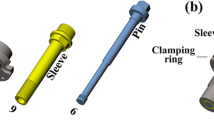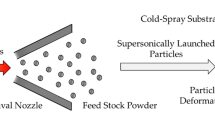Abstract
The friction deposition process is well known for surface repairs and depositing corrosion and wear resistant coatings. In this study, we explored friction deposition additive manufacturing (FDAM) for producing alloy 718 components. The microstructure evolution, temperature distribution during the process, and room temperature tensile properties of the FDAM processed alloy 718 were studied. Multi-layer deposits with sound metallurgical bonding at the layer interfaces were obtained. The deposits showed fine equiaxed grains with grain size varying from 4 to 7 μm across the deposit height, having finer grains (~4 μm) closer to the substrate and coarser grains (~7 μm) at the top of the deposit. Thermography analysis was employed to analyze the temperature distribution during friction deposition, revealing a maximum peak temperature of 1121°C on the deposited material. Subsequently, the material cooled rapidly at a rate of 30°C/s. The FDAM sample in the as-deposited condition exhibited higher tensile strength than the wrought alloy 718 in the solution-treated (ST) condition. The post-direct aging (DA) of the FDAM sample resulted in a 41% improvement in tensile strength than the as-deposited condition and met the tensile properties of wrought alloy 718 in aged condition as per aerospace material specifications (AMS). Furthermore, there were no significant variations observed in the tensile properties across different regions of the FDAM deposit height.
Graphical abstract

























Similar content being viewed by others
Data availability
The data that support the findings of this study are available from the corresponding author upon reasonable request.
References
Mannava V, Rao AS, Paulose N et al (2016) Hot corrosion studies on Ni-base superalloy at 650°C under marine-like environment conditions using three salt mixture (Na2SO4 + NaCl + NaVO3). Corros Sci 105:109–119. https://doi.org/10.1016/j.corsci.2016.01.008
Damodaram R, Ganesh Sundara Raman S, Satyanarayana DVV et al (2014) Hot tensile and stress rupture behavior of friction welded alloy 718 in different pre-and post-weld heat treatment conditions. Mater Sci Eng A 612:414–422. https://doi.org/10.1016/j.msea.2014.06.076
Chen Y, Guo Y, Xu M et al (2019) Study on the element segregation and Laves phase formation in the laser metal deposited IN718 superalloy by flat top laser and gaussian distribution laser. Mater Sci Eng A 754:339–347. https://doi.org/10.1016/j.msea.2019.03.096
Farzadfar SA, Murtagh MJ, Venugopal N (2020) Impact of IN718 bimodal powder size distribution on the performance and productivity of laser powder bed fusion additive manufacturing process. Powder Technol 375:60–80. https://doi.org/10.1016/j.powtec.2020.07.092
Xu Y, Gong Y, Li P, Yang Y, Qi Y (2020) The effect of laser power on the microstructure and wear performance of IN718 superalloy fabricated by laser additive manufacturing. Int J Adv Manuf Technol 108(7–8):2245–2254. https://doi.org/10.1007/s00170-020-05172-6
Karimi P, Sadeghi E, Ålgårdh J et al (2020) Effect of build location on microstructural characteristics and corrosion behavior of EB-PBF built Alloy 718. Int J Adv Manuf Technol 106:3597–3607. https://doi.org/10.1007/s00170-019-04859-9
Teixeira Ó, Silva FJG, Atzeni E (2021) Residual stresses and heat treatments of Inconel 718 parts manufactured via metal laser beam powder bed fusion: an overview. Int J Adv Manuf Technol 113:3139–3162. https://doi.org/10.1007/s00170-021-06835-8
Nguyen QB, Nai MLS, Zhu Z et al (2017) Characteristics of Inconel powders for powder-bed additive manufacturing. Engineering 3:695–700. https://doi.org/10.1016/J.ENG.2017.05.012
Gotterbarm MR, Seifi M, Melzer D et al (2020) Small scale testing of IN718 single crystals manufactured by EB-PBF. Addit Manuf 36:101449. https://doi.org/10.1016/j.addma.2020.101449
Huynh L, Rotella J, Sangid MD (2016) Fatigue behavior of IN718 microtrusses produced via additive manufacturing. Mater Des 105:278–289. https://doi.org/10.1016/j.matdes.2016.05.032
Safronov VA, Khmyrov RS, Kotoban DV, Gusarov AV (2017) Distortions and residual stresses at layer-by-layer additive manufacturing by fusion. J Manuf Sci Eng Trans ASME 139:3–8. https://doi.org/10.1115/1.4034714
Parimi LL, Ravi G, Clark D, Attallah MM (2014) Microstructural and texture development in direct laser fabricated IN718. Mater Charact 89:102–111. https://doi.org/10.1016/j.matchar.2013.12.012
Dupont JN, Lippold JC, Kiser SD (2009) Welding metallurgy and weldability of nickel-base alloys. Wiley, New Jersey, pp 223–235
Khodabakhshi F, Gerlich AP (2018) Potentials and strategies of solid-state additive friction-stir manufacturing technology: a critical review. J Manuf Process 36:77–92. https://doi.org/10.1016/j.jmapro.2018.09.030
Seidi E, Miller SF, Carlson BE (2021) Friction surfacing deposition by consumable tools. J Manuf Sci Eng Trans ASME 143:1–26. https://doi.org/10.1115/1.4050924
Özcan ME (2022) The influence of parameters on the evolution of the friction surfacing method - a review. J Mech Sci Technol 36:723–730. https://doi.org/10.1007/s12206-022-0120-z
Gandra J, Krohn H, Miranda RM et al (2014) Friction surfacing - a review. J Mater Process Technol 214:1062–1093. https://doi.org/10.1016/j.jmatprotec.2013.12.008
Dilip JJS, Babu S, Varadha Rajan S, Rafi KH, Janaki Ram G, Stucker BE (2013) Use of friction surfacing for additive manufacturing. Mater Manuf Process 28(2):189–194. https://doi.org/10.1080/10426914.2012.677912
Seidi E, Miller SF (2020) A novel approach to friction surfacing: experimental analysis of deposition from radial surface of a consumable tool. Coatings 10:1–17. https://doi.org/10.3390/coatings10111016
Seidi E, Miller SF (2022) Feasibility of multilayer solid-state deposition via lateral friction surfacing for metal additive manufacturing. J Mater Res Technol 20:1708–1725. https://doi.org/10.1016/j.jmrt.2022.07.158
Karthik GM, Janaki Ram GD, Kottada RS (2017) Use of friction buttering for overcoming HAZ liquation cracking. Metall Mater Trans B Process Metall Mater Process Sci 48:2274–2280. https://doi.org/10.1007/s11663-017-1039-0
Dilip JJS, Rafi HK, Ram GDJ (2011) A new additive manufacturing process based on friction deposition. Trans Indian Inst Met 64:27–30. https://doi.org/10.1007/s12666-011-0005-9
Cyril Joseph Daniel S, Damodaram R, Karthik GM, Lakshmana Rao B (2022) Friction surfaced alloy 718 deposits: effect of process parameters on coating performance. J Mater Eng Perform 31:4119–4132. https://doi.org/10.1007/s11665-021-06488-4
Rai P, Daniel SCJ, Damodaram R, Yadav D (2023) Microstructural characterization, mechanical properties and thermal stability of friction surfaced Inconel 718 coatings. Metall Mater Trans A Phys Metall Mater Sci. https://doi.org/10.1007/s11661-023-07031-x
Tabaie S, Rézaï-Aria F, Flipo BCD, Jahazi M (2021) Grain size and misorientation evolution in linear friction welding of additively manufactured IN718 to forged superalloy AD730TM. Mater Charact 171:110766. https://doi.org/10.1016/j.matchar.2020.110766
Griffiths RJ, Garcia D, Song J et al (2021) Solid-state additive manufacturing of aluminum and copper using additive friction stir deposition: process-microstructure linkages. Materialia 15:100967. https://doi.org/10.1016/j.mtla.2020.100967
Yu HZ, Mishra RS (2021) Additive friction stir deposition: a deformation processing route to metal additive manufacturing. Mater Res Lett 9:71–83. https://doi.org/10.1080/21663831.2020.1847211
Dilip JJS, Ram GDJ, Stucker BE (2012) Additive manufacturing with friction welding and friction deposition processes. Int J Rapid Manuf 3:56. https://doi.org/10.1504/ijrapidm.2012.046574
Dilip JJS, Janaki Ram GD (2014) Friction freeform fabrication of superalloy inconel 718: prospects and problems. Metall Mater Trans B Process Metall Mater Process Sci 45:182–192. https://doi.org/10.1007/s11663-013-0003-x
Damodaram R, Rai P, Cyril Joseph Daniel S et al (2021) Friction surfacing: a tool for surface crack repair. Surf Coat Technol 422:127482. https://doi.org/10.1016/j.surfcoat.2021.127482
Kuo YL, Horikawa S, Kakehi K (2017) The effect of interdendritic δ phase on the mechanical properties of Alloy 718 built up by additive manufacturing. Mater Des 116:411–418. https://doi.org/10.1016/j.matdes.2016.12.026
Thomas WM, Richards BJ, Bedford GM et al (1984) An introduction to friction surfacing, pp 327–331
Stegmueller MJR, Grant RJ, Schindele P (2019) Quantification of the interfacial roughness when coating stainless steel onto aluminium by friction surfacing. Surf Coat Technol 375:22–33. https://doi.org/10.1016/j.surfcoat.2019.06.060
Gandra J, Miranda RM, Vilaça P (2012) Performance analysis of friction surfacing. J Mater Process Technol 212:1676–1686. https://doi.org/10.1016/j.jmatprotec.2012.03.013
Graff P, Ståhlbom B, Nordenberg E et al (2017) Evaluating measuring techniques for occupational exposure during additive manufacturing of metals: a pilot study. J Ind Ecol 21:S120–S129. https://doi.org/10.1111/jiec.12498
Song KH, Nakata K (2010) Microstructural and mechanical properties of friction-stir-welded and post-heat-treated Inconel 718 alloy. J Alloys Compd 505:144–150. https://doi.org/10.1016/j.jallcom.2010.06.016
Kumar VP, Jebaraj AV (2022) Attainment of favorable microstructure for residual stress reduction through high-temperature heat treatment on additive manufactured inconel 718 alloy. Int J Adv Manuf Technol 121:4455–4472. https://doi.org/10.1007/s00170-022-09640-z
Sundararaman M, Mukhopadhyay P, Banerjee S (1988) Deformation behaviour of γ″ strengthened inconel 718. Acta Metall 36:847–864. https://doi.org/10.1016/0001-6160(88)90139-3
Liu FC, Nelson TW (2018) Twining and dynamic recrystallization in austenitic Alloy 718 during friction welding. Mater Charact 140:39–44. https://doi.org/10.1016/j.matchar.2018.03.035
Moretti MA, Dalai B, Åkerström P et al (2021) High strain rate deformation behavior and recrystallization of alloy 718. Metall Mater Trans A Phys Metall Mater Sci 52:5243–5257. https://doi.org/10.1007/s11661-021-06463-7
Calandri M, Yin S, Aldwell B et al (2019) Texture and microstructural features at different length scales in Inconel 718 produced by selective laser melting. Materials 12. https://doi.org/10.3390/ma12081293
Liu XM, Zou ZD, Zhang YH et al (2008) Transferring mechanism of the coating rod in friction surfacing. Surf Coat Technol 202:1889–1894. https://doi.org/10.1016/j.surfcoat.2007.08.024
Gandra J, Pereira D, Miranda RM et al (2013) Deposition of AA6082-T6 over AA2024-T3 by friction surfacing - mechanical and wear characterization. Surf Coat Technol 223:32–40. https://doi.org/10.1016/j.surfcoat.2013.02.023
Rafi HK, Ram GDJ, Phanikumar G, Rao KP (2011) Microstructural evolution during friction surfacing of tool steel H13. Mater Des 32:82–87. https://doi.org/10.1016/j.matdes.2010.06.031
Khalid Rafi H, Balasubramaniam K, Phanikumar G, Prasad Rao K (2011) Thermal profiling using infrared thermography in friction surfacing. Metall Mater Trans A Phys Metall Mater Sci 42:3425–3429. https://doi.org/10.1007/s11661-011-0750-8
Khalid Rafi H, Phanikumar G, Prasad Rao K (2011) Material flow visualization during friction surfacing. Metall Mater Trans A Phys Metall Mater Sci 42:937–939. https://doi.org/10.1007/s11661-011-0614-2
McLouth TD, Witkin DB, Bean GE et al (2020) Variations in ambient and elevated temperature mechanical behavior of IN718 manufactured by selective laser melting via process parameter control. Mater Sci Eng A 780:139184. https://doi.org/10.1016/j.msea.2020.139184
AMS 5596 (2017) Aerospace material specification for Inconel 718. SAE International. https://www.sae.org/standards/content/ams5596m. https://doi.org/10.4271/AMS5596M
Kirka MM, Medina F, Dehoff R, Okello A (2017) Mechanical behavior of post-processed Inconel 718 manufactured through the electron beam melting process. Mater Sci Eng A 680:338–346. https://doi.org/10.1016/j.msea.2016.10.069
Xu X, Ding J, Ganguly S, Williams S (2019) Investigation of process factors affecting mechanical properties of INCONEL 718 superalloy in wire + arc additive manufacture process. J Mater Process Technol 265:201–209. https://doi.org/10.1016/j.jmatprotec.2018.10.023
Acknowledgements
The authors would like to thank the joining and additive manufacturing laboratory, Indian Institute of Technology Madras (IITM), India for facilitating the friction deposition machine to conduct the FDAM experiments.
Funding
This work was supported by the Department of Science and Technology (DST), Science and Engineering Research Board (SERB), Early Career Research (ECR) Award (Ref: ECR/2015/000416).
Author information
Authors and Affiliations
Contributions
Mr. Cyril Joseph Daniel Santiagu: Conceptualization, Material preparation, Experimental design, Characterization, Data collection and Manuscript writing. Dr. Damodaram Ramachandran: Conceptualization, Funding acquisition, Experimental design, Characterization, Data collection, Manuscript writing, review and editing. Dr. Karthik Gangaraju Manogna: Conceptualization, Characterization, Result analysis, Manuscript review and editing. Dr. Sajja Rama Koteswara Rao: Result analysis, Manuscript review and editing. All authors reviewed and provided comments regarding previous versions of the manuscript and approved the final version of the manuscript.
Corresponding author
Ethics declarations
Conflict of interest
The authors declare no competing interests.
Additional information
Publisher’s note
Springer Nature remains neutral with regard to jurisdictional claims in published maps and institutional affiliations.
Rights and permissions
Springer Nature or its licensor (e.g. a society or other partner) holds exclusive rights to this article under a publishing agreement with the author(s) or other rightsholder(s); author self-archiving of the accepted manuscript version of this article is solely governed by the terms of such publishing agreement and applicable law.
About this article
Cite this article
Santiagu, C.J.D., Ramachandran, D., Gangaraju, M. et al. Friction deposition additive manufacturing of alloy 718: Effect of post-heat treatment on microstructures and mechanical properties. Int J Adv Manuf Technol 128, 3901–3919 (2023). https://doi.org/10.1007/s00170-023-12141-2
Received:
Accepted:
Published:
Issue Date:
DOI: https://doi.org/10.1007/s00170-023-12141-2




